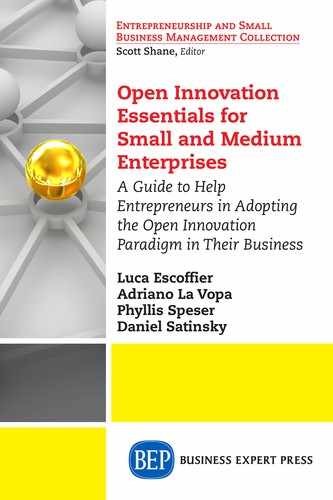Adner, Ron, 59
Advisors, 109
Amortized intellectual property, 13
Angel investors, 142–143
Auctions. See Intellectual property (IP) auctions
Backward chaining, 37–39
Bottom-up approach
creating, developing, and selling, 87–88
overview of, 84–85
pros and cons, 86–87
using own network, 85–87
Boyer, Herbert, 5
Broker, 19
Brokerage. See Intellectual property (IP) brokerage
Bureaucracy, 5
Business plan competitions, 138
Closed innovation, 3–5
Closed silo mindset, 5–6
Competitive advantage, 41
Consultants, 109
Convergence process, 50
Corporate investment, 141–142
Costs of goods sold, 11–12
Crowdfunding
definition, 144
equity based, 146
lending based, 145–146
project based, 144–145
Crowds
advisors, 109
consultants, 109
experts, 107
hobbyists, 110
inventors, 107
key users, 109–110
lead users, 108–109
opinion leaders, 109
tourists, 111
Crowdsourcing
bottom-up approach. See Bottom-up approach
challenges, 95
conducting outreach, 94–97
cycle, 77
defining needs, 88–91
definition, 9, 75–79
feasibility study, 102
gathering and assessing solutions, 97–102
intermediaries. See Intermediaries
landscape, 10
motivations and rewards, 111–114
overview of, 73–75
risks. See Risks of crowdsourcing
step-by-step approach, 91–93
takeaways, 117–119
top-down approach. See Top-down approach
types of communities and density of participants, 78
Cultural differences, 117
Deal-making process, 68–69
Delphi method, 60–61
Diffusion of Innovations (Rogers), 108
EAIP. See Easy Access Intellectual Property
Ease of use, 39
Easy Access Intellectual Property (EAIP), 22–24
EEN. See Enterprise Europe Network
End user license agreement (EULA), 115
Enterprise Europe Network (EEN), 26–27
Equity based crowdfunding, 146
EULA. See End user license agreement
Exit strategy, 147–148
Firm-specific risk, 33
Franklin, Benjamin, 69–70
Free money, 58–64
Funding, 137–139
Gates, Bill, 5
Global Technology Portal, 22
Goodwill, 13
Gross profit, 11
Hobbyists, 110
House of Quality, 48–49
Howe, Jeff, 76, 144
Hybrid models, 29–31
iBridge Network, 24–26
Immature technologies, 48
Innovation ecosystem, 132
Innovation funnel, 2–3
Inside-out open innovation, 7–9
Intellectual property (IP)
protection, 114–115
risk, 33
surplus, 154–155
transactions, 55–56
Intellectual property (IP) auctions
circumstances, 18
description, 19
hybrid models, 29–31
working principles, 28–29
Intellectual property (IP) brokerage
description, 19
Easy Access IP, 22–24
Enterprise Europe Network, 26–27
iBridge Network, 24–26
Japan Technology Transfer Helpdesk, 27–28
Intermediaries
network, 103–104
solutions, 105
support and services, 104–105
top-down approach, 80–82
Interval scales, 38
Invention disclosures, 20–21
IP. See Intellectual property
Jacobs, Madeleine, 130
Japan Technology Transfer Helpdesk, 27–28
Joy, Bill, 8
Jumpstart Our Business Startups Act, 146
Key users, 109–110
Legal transaction, 49
Lending based crowdfunding, 145–146
Market intelligence, 134–137
Market transaction, 49–50
NASA. See National Aeronautics and Space Administration
National Aeronautics and Space Administration (NASA), 128–130
Negotiation
convergence process, 50
getting to, 68–71
IP transactions, 55–56
legal transaction, 49
market transaction, 49–50
net present value, 53–54, 56
Probability of Beauty contests, 54
process technologies, 51
royalty rate calculator, 56–58
technology to market depiction, 52–53
Net present value (NPV), 53–54, 56
Net revenues from IP, 12–13
Not invented here (NIH) syndrome, 4–5
NPV. See Net present value
OIAs. See Open Innovation Accelerators
Open innovation
closed innovation and, 3–5
corporate paradigm, 8
description, 2–3
funnel management, 2–3
inside-out, 7–9
NIH syndrome, 4–5
outside-in, 7–9
paradigm, 4, 6
Open Innovation Accelerators (OIAs), 102
Open innovation market opportunity
funding, 137–139
market intelligence, 134–137
overview of, 124–127
team, 130–134
technology, 127–130
Open innovation practice
amortized IP, 13
costs of goods sold, 11–12
goodwill, 13
gross profit, 11
net revenues from IP, 12–13
overview of, 9
stock price, 13–14
Open mindset, 5–7
Opinion leaders, 109
Ordinal scales, 38
Outside-in open innovation, 7–9
Performance, scale dimension, 38
PFE. See Proudly found elsewhere
PMWS. See Program Managers Workstation
Porter, Michael, 47–48
Price, scale dimension, 39
Probability of Beauty (P-Beauty) contests, 54
Program Managers Workstation (PMWS), 68
Project based crowdfunding, 144–145
Proudly found elsewhere (PFE), 6–7
Quality Function Deployment tool, 48–49
Quantification of scales, 38
Quantity vs. quality, 116
Ratio scales, 38
Recursive Hierarchical Segmentation (RHSEG), 47
RHSEG. See Recursive Hierarchical Segmentation
Risk reduction plans, 66–68
Risks of crowdsourcing
binding terms and conditions, 116–117
cultural differences, 117
quantity versus quality, 116
telling the world, 115
trust, 115–116
Rogers, Everett, 108
Royalty rate calculator, 56–58
Scale dimensions
ease of use, 39
performance, 38
price, 39
Scale quantification, 38
Shaw, George Bernard, 111–112
Small and medium-sized enterprises (SMEs), 19
Small Business Innovation Development Act, 140
Small Business Innovation Research (SBIR) program, 139–140
Small Business Investment Act, 143
Small Business Technology Transfer (STTR) program, 139–140
SMEs. See Small and medium-sized enterprises
Speser, David, 9
Spin-up business model. See also Open innovation market opportunity
angel investors, 142–143
corporate investment, 141–142
crownfunding, 144–147
exit strategy, 147–148
formation of, 123–124
goal of, 123
institutional forces, 122
purpose of, 121
SBIR program, 139–140
STTR program, 139–140
success factors, 148–150
venture capital, 143
Stakeholder table, 59–60
Stock price, 13–14
Surplus intellectual property, 154–155
Technical due diligence, 40–41
Technical Risk Identification and Mitigation System (TRIMS), 68
Technological invention, reasons, 33
Technology accelerators, 138
Technology readiness level (TRL), 65–66, 127–130
Technology space, 153
Technology transfer
backward chaining with customers, 37–39
exit process, 68–71
finding to acquire technology, 40–49
matrix relationships, 45–46
negotiating to acquire technology. See Negotiation
obtaining free money, 58–64
overview of, 36–37
patent requirements, 42–43
patent strength, 44
Porter’s value chain, 47–48
process technologies, 42
Quality Function Deployment tool, 48–49
specific capabilities and resources, 45
trade-off analysis, 40–41
transitioning, 64–68
Technology transfer offices (TTOs)
description, 20–21
perspectives, 34–35
Top-down approach
company-owned portal, 83–84
intermediaries, 80–82
overview of, 79–80
summary, 84
Tourists, 111
Transitioning, 64–68
TRIMS. See Technical Risk Identification and Mitigation System
TRL. See Technology readiness level
Trust, 115–116
TTOs. See Technology transfer offices
U.S. Bayh-Dole Act, 125
Value chain, 47–48
Venture capital, 143
Wetzel, William, 142
The Wide Lens: What Successful Innovators See That Others Miss (Adner), 59
WIPO. See World Intellectual Property Organization
Wired magazine, 76
World Intellectual Property Organization (WIPO), 28, 43
Zuckerberg, Mark, 5
